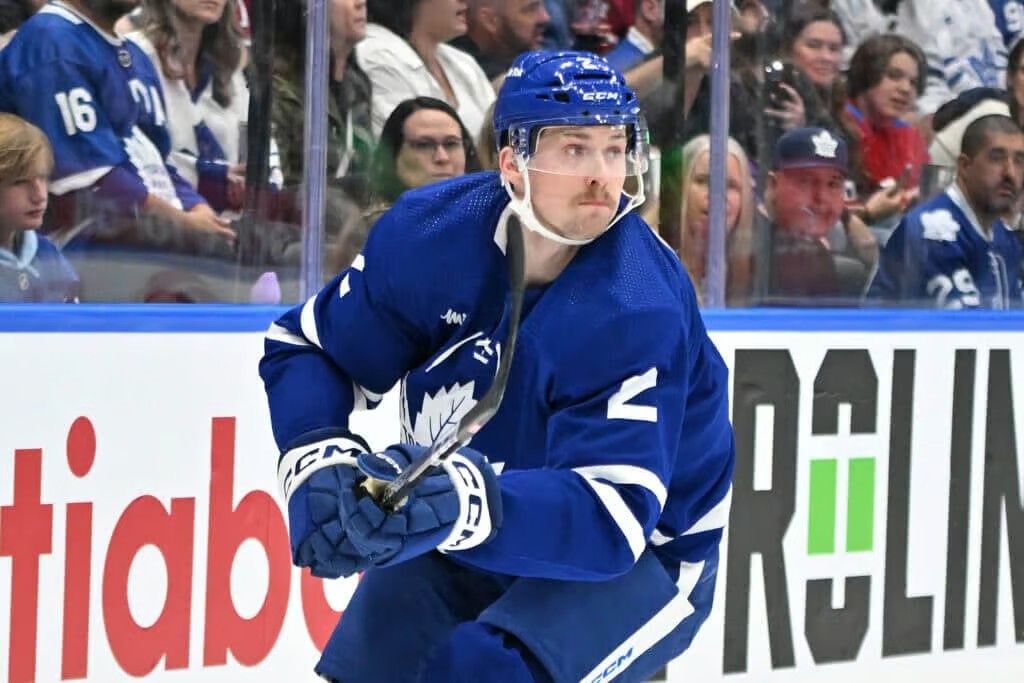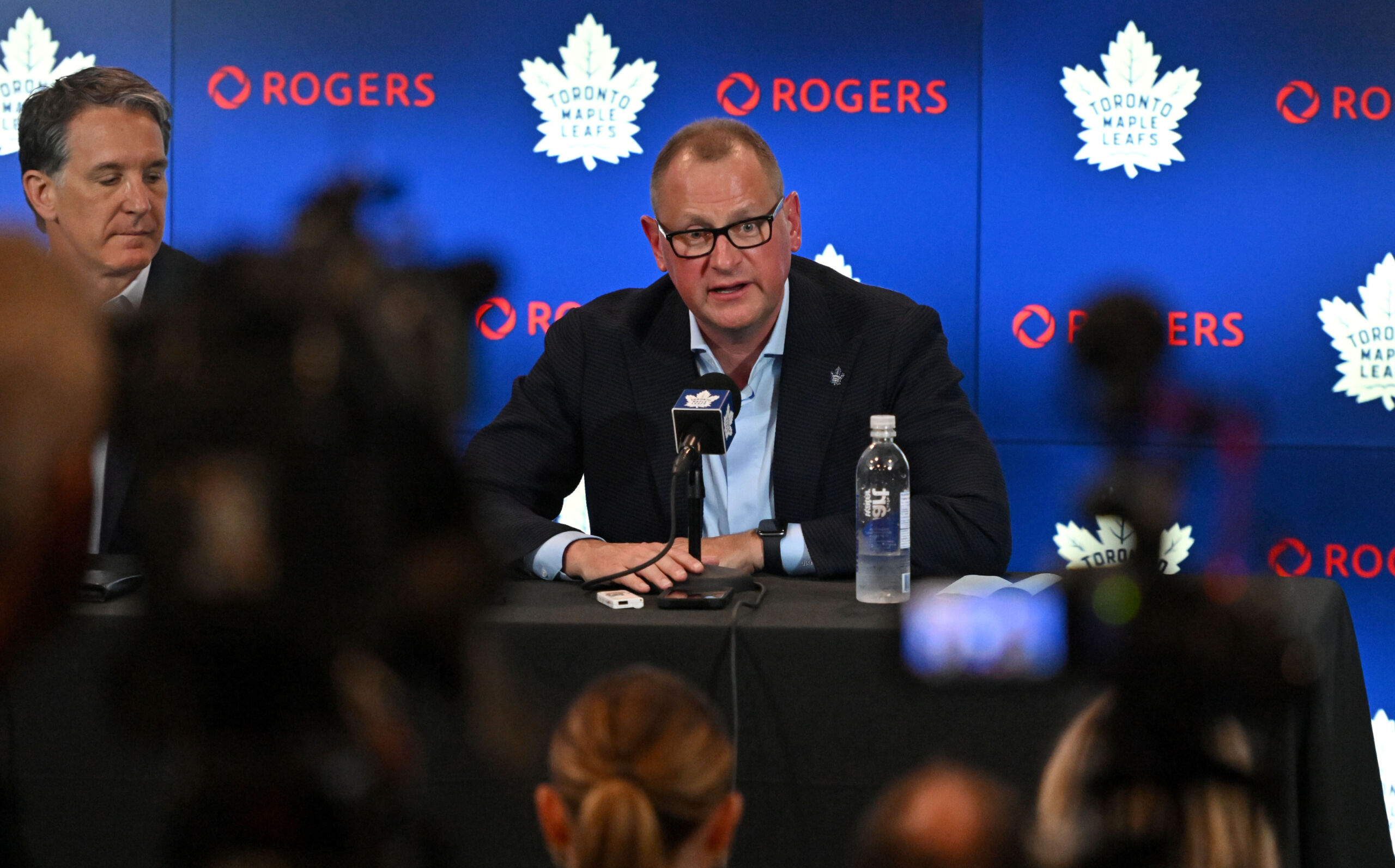The Maple Leafs’ defense has been a major talking point throughout the 2023-24 season in part because General Manager Brad Treliving has been fairly direct in acknowledging that he would like to improve it.
While the Leafs have gotten off to a strong start in the standings (16-6-6), it would be fair to attribute some of the team’s middling results to their relative weakness on defense. The team is 18th in shot attempt share at five-on-five, 19th in expected goals, and is only outscoring opponents 64-60 at five-on-five to this point (they were below 50% in five-on-five goal share before Saturday’s blowout win over Pittsburgh).
The Leafs forwards are talented, and there is scoring depth – the team ranks second in the league in goals per game. Where they often run into trouble is breaking out and moving the puck up the ice cleanly and efficiently.
Prime examples were visible in the wild Columbus game last week. Sheldon Keefe lamented that multiple Blue Jackets goals came after the Leafs simply gave the puck away while in full possession in their own zone. One of those goals, in particular, came after a simple D-to-D passing play was botched between Jake McCabe and Conor Timmins.
Now, a good chunk of these struggles have been the direct result of injuries on the blue line. Two of their regular defensemen lately, William Lagesson and Simon Benoit, were on waivers to start the season and went unclaimed. The same applies to Max Lajoie, who has appeared in four games.
But Lagesson and Benoit have been pleasant surprises. Conor Timmins has finally returned to health and is stringing some games together. Now that the Leafs are starting to get healthy on defense (Timothy Liljegren returned on Saturday), the conversation has shifted somewhat.
Why the need resides at the top of the defensive depth chart

The Leafs still need to add quality at the top end of their defense core, but we’ve learned through the injury adversity that there is reasonable depth at the position within the organization currently.
Benoit and Lagesson, in particular, have shown that they are useful players who can handle depth minutes capably. Benoit is averaging 14:50 per game and Lagesson is averaging 15:13. They will need to prove that they can remain serviceable as the season continues – the hockey will become tighter and more difficult – but there has been enough to go on within their performances to be optimistic about their ability to play serviceable NHL minutes.
Since the Leafs took off for Sweden a month ago, the team has the number-two ranked penalty kill in the league at 91.4 percent. Lagesson has played 1:52 per game shorthanded over that time while Benoit has averaged 1:27. Both have been second-unit staples when in the lineup. Benoit is the more physical option (he leads Leafs defensemen in hits per 60 minutes) while Lagesson is a little smoother (he has three points while Benoit is pointless).
And then there is Timmins, who provides a right-handed offensive defenseman option that no one else on the team comes close to providing. There are defensive warts to his game, but he also has produced 20 points in 36 games as a Leaf. That alone makes him an option worthy of consideration. If he can clean up some of the issues defensively with more reps (and he has missed a lot of hockey over the years, so he’ll need to prove he can stay healthy), it would really solidify his spot in the lineup.
Next up is the currently-injured Mark Giordano, who was logging nearly 18 minutes per game before the broken finger and was holding down top-four minutes when the Leafs needed it. On one hand, there’s evidence the oldest player in the league is very much still a capable contributor – and perhaps the current rest time will help him compared to last season when he played in 78 games and appeared to burn out in the playoffs. He really struggled with the pace and physicality last postseason.
Either way, that’s now four options for consideration for two depth spots. Should the Leafs acquire a top-four defenseman of some sort without losing a defenseman off their current roster, it would also bump down one of their current top-four defensemen to the third pairing.
Hypothetically, let’s say Treliving has acquired a right-handed partner for Morgan Rielly as the organization has done in each of the past two seasons. For argument’s sake, let’s say the coaching staff pushes Brodie down to lead a heavy-defensive-zone-usage third pairing while keeping McCabe in the top four as well as Liljegren, who is right-handed (it’s also worth noting that the McCabe – Brodie pairing struggled last playoffs).
Between Brodie, Giordano, Timmins, Benoit, and Lagesson, it would be hard to argue there isn’t at least one really useful pairing the team could put together. In my view, any combination of those options anchored by Brodie would be serviceable.
This leaves the Leafs with a clear need in the top four. It’s also why even though the cost the Canucks paid for Nikita Zadorov appeared modest, it made little sense to part with precious draft-pick capital (the Leafs don’t have a second-rounder for each of the next three years) to add a player who isn’t a bonafide top-four needle mover. Unless all of Benoit, Lagesson, Timmins, and Giordano fall off substantially over the next few months, there is enough depth in the organization to come up with multiple quality third-pairing combinations.
When we look at the top of the Eastern Conference standings, teams such as Boston (Charlie McAvoy and Hampus Lindholm), Florida (Aaron Ekblad, Gustav Forsling, and most likely Brandon Montour), and the Rangers (Adam Fox, K’Andre Miller, and probably Jacob Trouba), the Leafs go into those series at a huge disadvantage in terms of quality defensemen. Toronto can put Rielly’s name up against those players, but after him, there is a clear drop-off.
We’ve seen this reality play out in past playoffs once Jake Muzzin went down injured. Rielly is always one of the best defensemen in the series, but their opponent also has a top-pairing defender as well as the one or two next-best defensemen. I don’t think it’s any coincidence that the Leafs’ best playoff series in terms of the quality of their performances came in 2022 against Tampa when Muzzin played in all seven games and Toronto actually outscored the Lightning overall.
There should be one singular focus when it comes to addressing the Leafs’ defensive needs: adding a quality top-four defenseman. Ideally, the profile is a right-handed shot who can move the puck and is competent against the opposition’s best players (funny enough, Liljegren is a poor man’s version of this profile at the moment, which is why he should remain on the team as a 24-year-old with only 152 NHL games to his name).
Half the battle is properly identifying the needs in the first place. In Toronto, there is real depth coming together on defense (and in net, too, to say nothing of the obvious forward depth). The question now is how big of a swing Brad Treliving can muster to add a needle-moving defenseman, thereby putting the final pieces in place on a Maple Leafs roster with Stanley Cup contention potential.
Programming note: This week’s Notes, quotes, Tweets of the Week, and ‘5 Things I Think I’d Do’ will follow later today



































